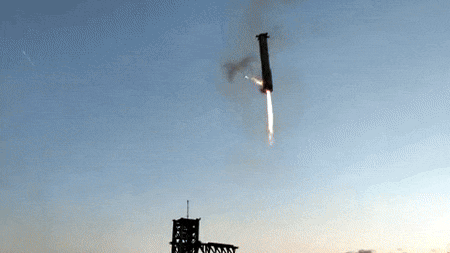On Sunday, SpaceX achieved a major milestone by launching its massive Starship rocket, in its boldest test flight to date. The towering rocket, which reached nearly 400 feet (121 meters) high, lifted off at dawn from a launch site in the southern tip of Texas, near the border with Mexico. The mission was intended to demonstrate the company’s ability to catch propellant returning to the launch pad using mechanical arms.
A historic launch
This flight marked a pivotal moment in SpaceX’s continued pursuit of reusable rocket technology. Unlike previous Starship missions, which ended in destruction shortly after takeoff or during splashdowns in the Gulf of Mexico, this test was aimed at a complete recovery. The last flight in June was considered the most successful to date, as it completed its mission without exploding but failed to recover the propellant.
A bold challenge
SpaceX founder and CEO Elon Musk significantly raised the stakes for this flight. The first stage booster returned to the launch pad just seven minutes after takeoff, landing gently thanks to the launch tower’s huge metal arms, known as “chopsticks.” The successful capture was received with joy among SpaceX employees, who celebrated the moment. “The tower has caught the rocket!!” Musk announced via X, echoing the excitement felt at the launch site.
Engineering wonder
“Even today, what we just saw is magical,” said Dan Huot, a SpaceX official who witnessed the landing. “I’m shaking right now.” Kate Tice, another SpaceX representative, added: “Folks, this is a day for the engineering history books.”
Decision making in real time
The landing decision fell to the flight director, who evaluated the conditions in real time. Both the booster and the launch tower had to be in stable condition for the capture to be made. Fortunately, everything aligned, allowing for a successful recovery, preventing the booster from ending up in the Gulf like previous missions.
Completing the mission
Once the booster was secured, the retro-looking stainless steel spacecraft continued its trajectory, aiming for a controlled splashdown in the Indian Ocean, where it would eventually sink after completing its mission. The total duration of the flight was expected to last just over an hour.
Looking to the future
This test flight is the culmination of SpaceX’s efforts to improve the performance of its rockets. After the June flight, in which parts came off during ascent, the company updated its software and modified the heat shield, improving the thermal plates to withstand the rigors of flight.
SpaceX has successfully recovered the first stage boosters of its Falcon 9 rockets for nine years, landing them on floating platforms or concrete slabs far from launch sites. In contrast, the Starship booster was successfully captured on the launch pad, paving the way for future missions. Musk intends to use this technology for Starship, the largest and most powerful rocket ever built, with 33 engines fueled by methane. NASA has already commissioned two Starships for lunar missions in the next decade, while SpaceX plans to use Starship to send people and supplies to both the Moon and Mars.
Disclaimer:
The information contained in this post is for general information purposes only. We make no representations or warranties of any kind, express or implied, about the completeness, accuracy, reliability, suitability or availability with respect to the website or the information, products, services, or related graphics contained on the post for any purpose.
We respect the intellectual property rights of content creators. If you are the owner of any material featured on our website and have concerns about its use, please contact us. We are committed to addressing any copyright issues promptly and will remove any material within 2 days of receiving a request from the rightful owner.

